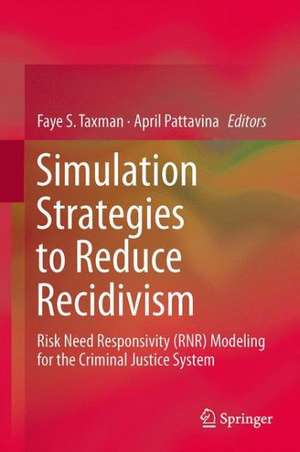Simulation Strategies to Reduce Recidivism: Risk Need Responsivity (RNR) Modeling for the Criminal Justice System
Editat de Faye S. Taxman, April Pattavinaen Limba Engleză Hardback – 6 iun 2013
As simulation modeling has becoming a more popular technique across many disciplines, and technology as well as the technical skills of researchers has improved, this book revisits the concept of simulation modeling with new applications for the criminal justice system. The wider availability of data has made for more opportunity to verify and validate models; computing software has become more available and easier to use; and the capacity for visualization and communication of models shows promise for the future of simulation in criminal justice.
The time has come to examine the past, present, and future contributions of simulation modeling to the field of criminal justice. This work provides a central resource of information for the current state of simulation modeling, and overview of existing techniques and cases of success, and directions for future development. This work will be an important resource for researchers in criminal justice and related fields, as well as those studying policy-related topics.
| Toate formatele și edițiile | Preț | Express |
|---|---|---|
| Paperback (1) | 641.85 lei 43-57 zile | |
| Springer – 24 iul 2015 | 641.85 lei 43-57 zile | |
| Hardback (1) | 648.24 lei 43-57 zile | |
| Springer – 6 iun 2013 | 648.24 lei 43-57 zile |
Preț: 648.24 lei
Preț vechi: 762.64 lei
-15% Nou
Puncte Express: 972
Preț estimativ în valută:
124.04€ • 129.84$ • 103.24£
124.04€ • 129.84$ • 103.24£
Carte tipărită la comandă
Livrare economică 31 martie-14 aprilie
Preluare comenzi: 021 569.72.76
Specificații
ISBN-13: 9781461461876
ISBN-10: 1461461871
Pagini: 328
Ilustrații: XI, 315 p. 30 illus.
Dimensiuni: 155 x 235 x 23 mm
Greutate: 0.64 kg
Ediția:2013
Editura: Springer
Colecția Springer
Locul publicării:New York, NY, United States
ISBN-10: 1461461871
Pagini: 328
Ilustrații: XI, 315 p. 30 illus.
Dimensiuni: 155 x 235 x 23 mm
Greutate: 0.64 kg
Ediția:2013
Editura: Springer
Colecția Springer
Locul publicării:New York, NY, United States
Public țintă
ResearchCuprins
Introduction.- The Stages of Simulation Models in Criminal Justice.- Simulation Language, Software, and Data Needs.- Using Simulation Methods to Estimate the Cost of Policy Choices.- A Dynamic Systems Approach to Examining Sentencing Alternatives.- Assessing Correctional Treatment Outcomes with Simulation Techniques.- A Discrete-Event Simulation Model of Heroine Use and Treatment Over the Lifecourse.- Using Evidence-Based Research to Inform Model Assumptions.- Developing Synthetic Data for Criminal Justice Simulation.- The Growing Use of Simulation Techniques by Sentencing Commissions.- Creating and Sustaining Organizational Support for Simulation Use.- Maintaining Agency-Based Simulation Models.- The Benefits of Using Simulation from Criminal Justice Education.
Notă biografică
April Pattavina, Ph.D. is an Associate Professor in the Department of Criminal Justice and Criminology at the University of Massachusetts Lowell. Dr. Pattavina has written extensively on the use of technology in the criminal justice system. Faye S. Taxman, Ph.D.is a University Professor in the Criminology, Law and Society Department and Director of the Center for Advancing Correctional Excellence at George Mason University. Dr. Taxman has over 30 years of experience in conducting research in the areas of sentencing, courts, corrections, and organizational change.
Textul de pe ultima copertă
Mass incarceration, the recession, and the swinging pendulum of correctional philosophies has put increasing attention on the use of evidence-based practices and treatments to guide the future direction of our criminal justice system. The Risk-Need-Responsivity (RNR) framework has emerged as a useful set of organizing principles for treating offenders. While the literature is supportive of the RNR approach, we understand little about the system impacts of moving in this direction. Some important questions include:
What would happen if we implemented RNR programming system-wide?
How can we simulate such a complex strategy?
What is the estimated impact on individuals, programs, and systems?
Simulation modeling can be used to address these basic questions. Since the 1970’s, simulation models have been used to capture the realities of the criminal justice system. Some early simulation projects were limited due to lack of data available to validate models, deficits in skills needed by staff to design and build models, and limited access to computing technology required to transform models into systems representations. This timely book revisits the concept of simulation modeling for the 21st century: the wider availability of data has created more opportunity to verify and validate models; computing software has become more available and easier to use; and the capacity for visualization and communication of models shows promise for the future of simulation in criminal justice.
This is an opportune time to make use of simulation models to examine the complex world of corrections and investigate the possible outcomes associated with implementing the RNR approach. Simulation Strategies to Reduce Recidivism provides a central source of information on the current state of simulation modeling in corrections. It includes anoverview of the methods used to build simulation models that address questions about appropriate placement of offenders in programs and controls, as well as applications of these models. Authors use simulation tools to investigate the impact of diversion programs, to map offender movement through programs and systems, and to address other grappling issues regarding the capability to build effective recidivism reduction systems.
This work will be an important resource for researchers in criminal justice and related fields, as well as those studying policy-related topics.
What would happen if we implemented RNR programming system-wide?
How can we simulate such a complex strategy?
What is the estimated impact on individuals, programs, and systems?
Simulation modeling can be used to address these basic questions. Since the 1970’s, simulation models have been used to capture the realities of the criminal justice system. Some early simulation projects were limited due to lack of data available to validate models, deficits in skills needed by staff to design and build models, and limited access to computing technology required to transform models into systems representations. This timely book revisits the concept of simulation modeling for the 21st century: the wider availability of data has created more opportunity to verify and validate models; computing software has become more available and easier to use; and the capacity for visualization and communication of models shows promise for the future of simulation in criminal justice.
This is an opportune time to make use of simulation models to examine the complex world of corrections and investigate the possible outcomes associated with implementing the RNR approach. Simulation Strategies to Reduce Recidivism provides a central source of information on the current state of simulation modeling in corrections. It includes anoverview of the methods used to build simulation models that address questions about appropriate placement of offenders in programs and controls, as well as applications of these models. Authors use simulation tools to investigate the impact of diversion programs, to map offender movement through programs and systems, and to address other grappling issues regarding the capability to build effective recidivism reduction systems.
This work will be an important resource for researchers in criminal justice and related fields, as well as those studying policy-related topics.
Caracteristici
Pulls together current research on simulation modelling and its applications for criminal justice Provides methodology for planning and carrying out a simulation model Identifies areas of new and emerging research, for future development Includes supplementary material: sn.pub/extras















